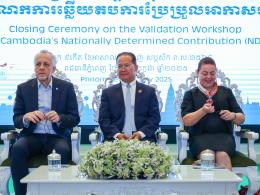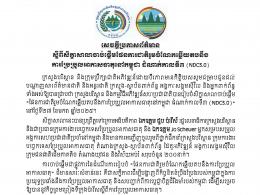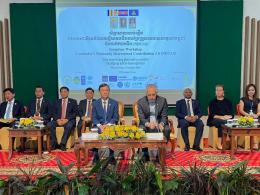by Dr. Keo Piseth
On 30 December 2021, Cambodia (https://ncsd.moe.gov.kh/node/12778) made a bold move in submitting its Long-Term Strategy for Carbon Neutrality to the Secretariat of the United Nations Framework Convention on Climate Change (UNFCCC). The move by Cambodia is warmly welcomed and applauded by the climate community, as Cambodia is one of the only forty-nine out of 197 parties of the Climate Conference and two of the Least Developed Countries that submitted the strategy with a clear target for carbon neutrality by 2050 (https://unfccc.int/process-and-meetings/the-convention/status-of-ratification/status-of-ratification-of-the-convention). The Paris (https://unfccc.int/process-and-meetings/the-paris-agreement/the-paris-agreement) Agreement 2015, which is a milestone document in the climate change process with a binding agreement adopted, stressed the need for all parties to formulate a Long-Term Strategy for Carbon Neutrality by mid-century, based on the principle of “Common But Differentiated Responsibilities And Respective Capabilities”, in order to limit the temperature increase by 2 degrees Celsius, preferably 1.5 degrees Celsius, by the end of the century. Furthermore, the recent 26th Conference of the Parties to the Climate Convention in Glasgow, Scotland, in November 2021 emphasised the importance of the Paris Agreement and stressed the urgency for more ambitious climate actions to achieve long-term global goals.
The strategy is another milestone document that Cambodia has produced (https://ncsd.moe.gov.kh/resources?q=ndc&idx=resource_type&p=0&dFR%5Bresource_category%5D%5B0%5D=Climate%20Change) as a party of UNFCCC, ranging from last year Updated Nationally Determined Contribution (2020) to Cambodia’s National Adaptation Plan Process (2017), and Bienniel Update Report (2020), Second National Communication (2015), and others. The strategy (https://unfccc.int/sites/default/files/resource/KHM_LTS_Dec2021.pdf) serves as a roadmap directing Cambodia’s development pathways towards a carbon-neutral and resilient future based on comprehensive analysis and modelling of relevant economic sectors. The document balances key areas fundamental to long-term national development, including Greenhouse Gas (GHG) emission reductions, economic growth, social justice, and climate resilience. It highlights that Cambodia could achieve carbon neutrality by 2050 through 1) the continuation of the implementation of the Reducing Emissions from Deforestation and Forest Degradation (REDD+) Strategy and reforms of the forestry sector, 2) gradual decarbonisation of the power and transport sectors, and higher energy efficiency, and 3) promotion of low-carbon agriculture practices, industrial processes, and waste management.
Notably, effective implementation of the strategy (https://unfccc.int/sites/default/files/resource/KHM_LTS_Dec2021.pdf) is expected to deliver an additional 2.8% of annual GDP growth (USD 4.2 billion), create 449,000 additional jobs by 2050, and contribute to the implementation of green-economy and low-carbon growth policy. Since 2016 (https://www.moe.gov.kh/index/31509), the country has generated US$11,6 million from carbon trading of two REDD+ in voluntary markets to international companies, including Disney, Kering, Intuit, Shell, and Gucci. The budget (https://seimaredd.wcs.org/) from trading has been spent on conserving and protecting biological resources and ecosystems and improving the livelihoods of local communities inhabiting the protected areas. Independent evaluations (https://cambodia.wcs.org/saving-wild-places/seima-forest.aspx) confirmed that the projects had contributed to reducing deforestation, biological loss, and local livelihood improvement.
Presently, under collaborations with international Non-Governmental Organisations (i.e. Wildlife Conservation Society, Conservation International) and transnational corporates (i.e. MITSUI & CO. LTD.), the Cambodian government is exploring the possibility to extend and pilot (https://www.moe.gov.kh/index/31509) REDD+ projects in other protected areas. With more REDD+ projects, it may be able to look into potential markets, which provide even better prices for carbon credits in addition to the existing voluntary carbon markets. For example, the price in the European market is approximately US$49.78 per ton (https://carbonpricingdashboard.worldbank.org/map_data) of carbon, four times slightly higher than the carbon price in the voluntary markets.
Besides the budget from carbon trading, forest ecosystems provide a vast array of economic benefits, including formal and informal employment in the forest sector, honey production, pharmaceutical business, eco-tourism development, and others. Moreover, invaluable ecosystem services, including genetic stock, carbon sequestration, soil preservation and protection, waste assimilation, water purification, plant pollination, hydrological cycle maintenance, and other functions, constitute the foundation of human existence. In addition, natural parks, mangroves, and green scenery contribute to human happiness, emotional sustenance and healing, and reduce air-pollution-borne diseases, such as heart, lung, cancer, and respiratory ailments.
In addition to the benefits highlighted above, the timely submission of the strategy demonstrates Cambodia’s serious commitments towards its climate actions. First, Cambodia’s Prime Minister’s promise (https://pressocm.gov.kh/en/archives/69443) at the UN Climate Ambition Summit in December 2020 to formulate and submit the document by the end of 2021 is honoured. Second, it reaffirms Cambodia’s bold commitment (https://www.moe.gov.kh/index/34879) made by the Minister of Environment, Cambodia’s Head of Delegates, at the 26th Conference of the Climate Parties, in addressing global warming, including 1) ending a new coal plant project, 2) no more commission of the hydropower dam construction on the mainstream Mekong River, and 3) achieving zero greenhouse gas emissions from the forestry sector by 2040, along with Cambodia ongoing efforts towards clean energy including the construction of 400-megawatts (https://www.moe.gov.kh/index/34879) solar power plant, which accounts for 15% of Cambodia’s power generation.
Nationally, Cambodia has made significant progress and achievements on climate responses from prioritising climate change in national development agenda to public investment for climate change, formulation of climate change strategic plan and sectoral plans, institutional strengthening, and climate mainstreaming into multi-sectors and sub-national levels. For instance, climate change was highlighted in the “Rectangular Strategy for Growth, Employment, Equity, and Efficiency (2019-2023), a guiding policy for inclusive and sustainable national development, stressing the need for intensifying the efforts to reduce the impacts of climate change by strengthening adaptation capacity and resilience to climate change, and to contribute to global GHGs reduction. Similarly, the National Strategic Development Plan (2019‐2023) emphasises the need to decarbonise the economy to combat climate change and sustainably manage natural resources to achieve sustainability and stability of Cambodia’s economic growth and development. Environmental issues, including climate change, are cross-cutting and require close collaboration among government agencies from both national and sub-national levels, donor countries, private sectors, international and national organisations (Royal Government of Cambodia (RGC) 2019). Furthermore, climate change has recently been integrated into the national economic recovery plan, and the new Investment Law (https://www.dfdl.com/resources/legal-and-tax-updates/cambodia-promulgation-of-the-law-on-investment/), which categorises climate change investment as qualified investment projects.
Despite the achievements, there remain major challenges, from limited financial and human resources to public behavioural change on waste management and energy conservation practices, and technological availability for Cambodia to fulfil the commitments under the strategy. This may require more assistance from developed countries through multilateral and bilateral mechanisms in financial and technical support and technology transfer for Cambodia to implement REDD+, access the European carbon markets, and provide effective interventions and assistance for climate change adaptation and other climate actions. Additionally, collaborations with development partners, international and national non-government organisations, research institutions, transnational and national corporates, and local communities are crucial for Cambodia to achieve climate goals and develop into a carbon-neutral and resilient society.
Dr Keo Piseth is Vice President of the Asian Vision Institute (AVI) and Director of the AVI Centre for Sustainable Development Studies.
Source: https://www.khmertimeskh.com/501009476/cambodias-long-term-strategy-for-carbon-neutrality-by-2050-a-bold-move-towards-climate-paris-agreement-and-sustainable-development/?p=1009476




